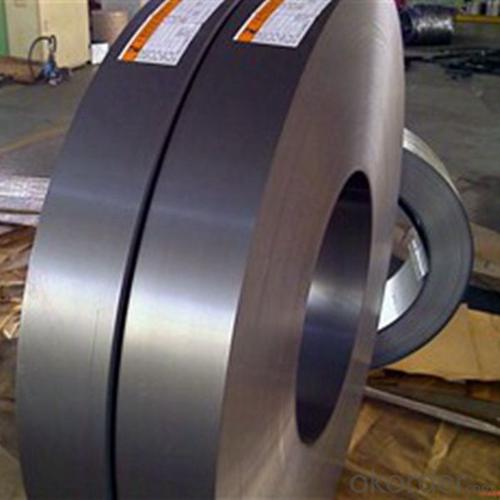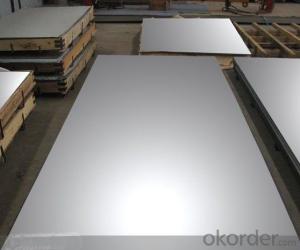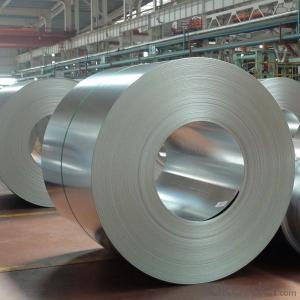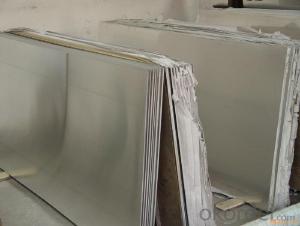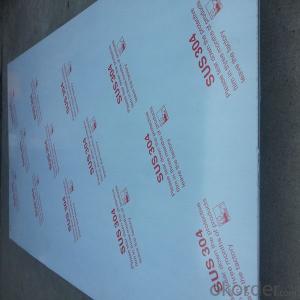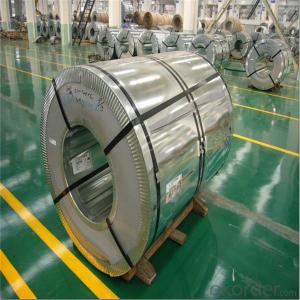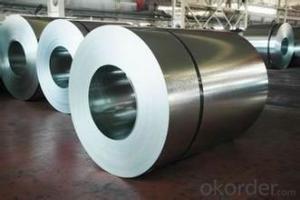Stainless Steel Coil and Stainless Steel Coil/Sheet ASTM A240/A480 State-Owned Factory
- Loading Port:
- Tianjin
- Payment Terms:
- TT OR LC
- Min Order Qty:
- 25 m.t.
- Supply Capability:
- 20000 m.t./month
OKorder Service Pledge
OKorder Financial Service
You Might Also Like
Specification
Specifications for Stainless Steel Coils/Sheets:
Type | 200 series,300 series,400 series |
Thickness | 1.8-8.0mm |
Widthness | 1000/1219/1500mm |
Technique | Hot Rolled/Cold Rolled |
Coil Weight | About 20 Tons |
Finish | NO.1/NO.2B |
Place of Origin | Made in China |
MOQ | 18 ton |
Color | Black,Mirror Finished |
Standard | ASTM, JIS, GB, BS, DIN etc |
Exporting countries | Peru,India,Pakistan,Singpore,Vietnam,South Korea,Malaysia etc. |
After-sales service | Factory Inspection |
Certifications | ISO,SGS |
Packaging | Standard export packing or following customer's demand |
Technical Notes:
Surface Finish | Definition | Application |
2B | Those finished, after cold rolling, by heat treatment, pickling or other equivalent treatment and lastly by cold rolling to given appropriate luster. | Medical equipment, Food industry, Construction material, Kitchen utensils. |
BA | Those processed with bright heat treatment after cold rolling. | Kitchen utensils, Electric equipment, Building construction. |
NO.3 | Those finished by polishing with No.100 to No.120 abrasives specified in JIS R6001. | Kitchen utensils, Building construction. |
NO.4 | Those finished by polishing with No.150 to No.180 abrasives specified in JIS R6001. | Kitchen utensils, Building construction, Medical equipment. |
HL | Those finished polishing so as to give continuous polishing streaks by using abrasive of suitable grain size. | Building Construction. |
NO.1 | The surface finished by heat treatment and pickling or processes corresponding there to after hot rolling. | Chemical tank, pipe |
Specifications for Stainless Steel Coils/Sheets:
Grade | C ≤ | Si ≤ | Mn ≤ | P ≤ | S ≤ | Ni ≤ | Cr ≤ |
201 | 0.12 | 0.75 | 7.00 | 0.045 | 0.045 | 1.00-1.28 | 13.70-15.70 |
202 | 0.15 | 1.00 | 2.25 | 0.045 | 0.045 | 4.07-4.17 | 14.00-16.00 |
304 | 0.08 | 0.75 | 2.00 | 0.045 | 0.03 | 8.00-11.00 | 18.00-20.00 |
304L | 0.035 | 0.75 | 2.00 | 0.045 | 0.03 | 8.00-13.00 | 18.00-20.00 |
309 | 0.15 | 0.75 | 2.00 | 0.045 | 0.03 | 12.00-15.00 | 22.00-24.00 |
310S | 0.08 | 1.50 | 2.00 | 0.045 | 0.03 | 19.00-22.00 | 24.00-26.00 |
316 | 0.08 | 1.00 | 2.00 | 0.045 | 0.03 | 10.00-14.00 | 16.00-18.00 |
316L | 0.035 | 0.75 | 2.00 | 0.045 | 0.03 | 10.00-15.00 | 16.00-18.00 |
321 | 0.04-0.10 | 0.75 | 2.00 | 0.045 | 0.03 | 9.00-13.00 | 17.00-20.00 |
405 | 0.08 | 0.75 | 1.00 | 0.045 | 0.03 | 0.06 | 11.5-13.5 |
409 | 0.089 | 1.00 | 1.00 | 0.045 | 0.05 | 0.06 | 10.50-11.75 |
410 | 0.15 | 0.75 | 1.00 | 0.045 | 0.03 | 0.06 | 11.5-13.5 |
420 | 0.16-0.25 | 1.00 | 1.00 | 0.040 | 0.03 | 0.06 | 12.00-14.00 |
430 | 0.12 | 0.75 | 1.00 | 0.045 | 0.03 | 0.06 | 16.00-18.00 |
Detailed Picture for Stainless Steel Coils/Sheets:
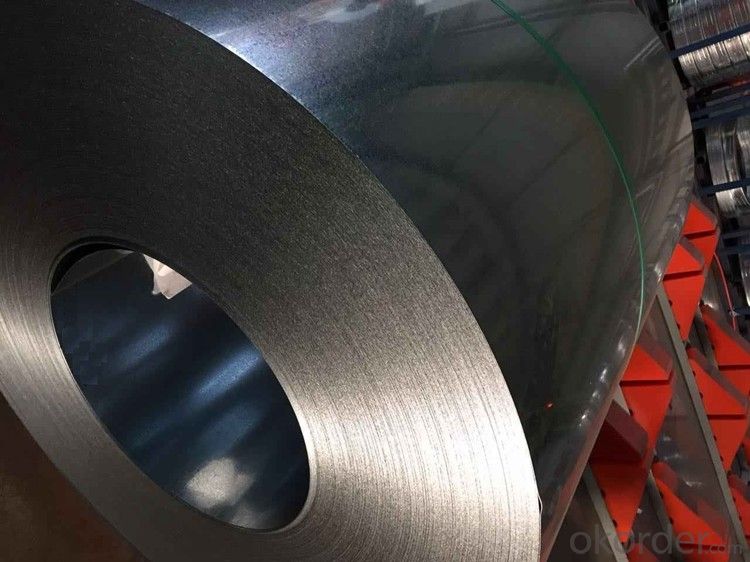
Packaging & Delivery for Stainless Steel Coils/Sheets:
Packaging Detail Standard export packing or following customer's demand
Delivery Time: Within 30-40 days after deposit or according to the order quantity
Export Markets for Stainless Steel Coils/Sheets:
Our target market is the international market. Every year we export most of products to countries like India, Pakistan, South Korea, Brazil, Australia, South Africa, Spain, Sri Lanka, Taiwan, Hong Kong, etc.
Our Service
1.High quanlity and reasonable price.
2.Customized on-demand.
3.Reasonable shipping and fast delivery.
4.Free sample.
FAQ for Stainless Steel Coils/Sheets:
Q:How to order?
A: Please send us your purchase order by email or fax .or you can ask us to send you a proforma invoice for your order .We need to know the following information for your order.
1) Shipping information-company name, street address, phone number, fax number, destination sea port
2) Product information – Quantity, Specification (steel type, thickness, width, surface finish)
3) Delivery time required
4) Forwarder's contact details if there's any in China
- Q: Can stainless steel sheets be used for decorative purposes?
- Yes, stainless steel sheets can be used for decorative purposes. They are known for their sleek and modern look, making them a popular choice for various decorative applications such as countertops, backsplashes, wall cladding, and furniture. Their durability, resistance to corrosion, and ability to maintain a clean appearance make them suitable for both indoor and outdoor decorative projects.
- Q: What are the different types of stainless steel sheet edges?
- The different types of stainless steel sheet edges include mill edge, slit edge, deburred edge, rounded edge, and beveled edge.
- Q: What are the different welding techniques used for stainless steel sheets?
- There are several welding techniques commonly used for stainless steel sheets, each with its own advantages and considerations. 1. TIG Welding (Gas Tungsten Arc Welding): TIG welding is a versatile and precise technique suitable for thin stainless steel sheets. It uses a non-consumable tungsten electrode to create an electric arc that melts and fuses the metals. TIG welding ensures high-quality welds with excellent aesthetic appearance and minimal heat distortion. 2. MIG Welding (Gas Metal Arc Welding): MIG welding is a popular technique for stainless steel sheets due to its efficiency and ease of use. It utilizes a consumable electrode wire and an inert gas shield to protect the weld from atmospheric contamination. MIG welding is faster than TIG welding and works well for thicker stainless steel sheets. 3. Spot Welding: Spot welding involves using electrodes to apply pressure and heat to join two stainless steel sheets together. This technique is commonly used in applications where a continuous seam is not required, such as for joining stainless steel sheets in automotive manufacturing or appliance production. 4. Plasma Arc Welding: Plasma arc welding is similar to TIG welding but uses a more concentrated arc produced by a constricted nozzle. This technique can achieve deeper penetration on stainless steel sheets and is often used for thicker materials or specialized applications. 5. Laser Welding: Laser welding is a precise and fast technique that uses a high-powered laser beam to melt and join the stainless steel sheets. It provides excellent control over the welding process and is suitable for thin to medium thickness stainless steel sheets. However, laser welding may require specialized equipment and expertise. Each welding technique has its own advantages and limitations, so the choice of technique depends on factors such as the thickness of the stainless steel sheets, desired weld quality, production speed, and available equipment.
- Q: Can stainless steel sheets be used for escalator cladding?
- Yes, stainless steel sheets can be used for escalator cladding. Stainless steel is a popular choice for cladding materials due to its durability, corrosion resistance, and aesthetic appeal. It can withstand heavy usage and is resistant to wear and tear, making it suitable for escalators. Stainless steel sheets can be fabricated into various shapes and sizes, allowing for customization and seamless installation on escalator surfaces. Additionally, stainless steel has a sleek and modern appearance, enhancing the overall aesthetics of the escalator.
- Q: Are stainless steel sheets suitable for water tanks?
- Yes, stainless steel sheets are suitable for water tanks. Stainless steel is highly resistant to corrosion, making it ideal for storing water. It does not react with the water or contaminate it with any harmful substances. Stainless steel tanks are durable, long-lasting, and low maintenance. They can withstand high temperatures and extreme weather conditions without compromising their structural integrity. Furthermore, stainless steel is non-porous and does not provide a breeding ground for bacteria or algae growth. These qualities make stainless steel sheets an excellent choice for water tanks in various applications, including residential, commercial, and industrial settings.
- Q: Can stainless steel sheets be used for marine propellers?
- Yes, stainless steel sheets can be used for marine propellers. Stainless steel is a popular choice for marine propellers due to its excellent corrosion resistance properties. The high levels of chromium in stainless steel make it resistant to rust and other forms of corrosion, even in saltwater environments. Additionally, stainless steel offers good strength and durability, making it suitable for withstanding the harsh conditions of marine environments. Stainless steel propellers are often preferred for boats and ships as they require less maintenance and have a longer lifespan compared to other materials. However, it is important to choose the appropriate grade of stainless steel for marine propellers to ensure optimal performance and longevity.
- Q: Can stainless steel sheets be used for elevator cabs?
- Yes, stainless steel sheets can be used for elevator cabs. Stainless steel is a common material choice for elevator cabs due to its durability, aesthetic appeal, and resistance to corrosion. It provides a sleek and modern look while also being able to withstand the wear and tear of daily use in elevators.
- Q: Can stainless steel sheets be used in chemical processing plants?
- Yes, stainless steel sheets can be used in chemical processing plants. Stainless steel is highly resistant to corrosion, making it an ideal material for use in environments where chemicals are present. It can withstand exposure to a wide range of chemicals, including acids, alkalis, and solvents, without deteriorating or reacting with them. Stainless steel sheets are also easy to clean and maintain, ensuring that they meet the strict hygiene and safety standards required in chemical processing plants. Additionally, stainless steel has excellent strength and durability, making it suitable for various applications within the plant, such as tanks, piping, pressure vessels, and heat exchangers. Overall, stainless steel sheets are a reliable and versatile choice for use in chemical processing plants.
- Q: What are the different types of stainless steel sheet finishes?
- There are several types of stainless steel sheet finishes, including No. 1, 2B, No. 4, BA, and satin.
- Q: Are stainless steel sheets resistant to chemicals?
- Yes, stainless steel sheets are generally resistant to chemicals. Due to their high levels of chromium and nickel, stainless steel sheets exhibit excellent resistance to corrosion from a wide range of chemicals, making them suitable for various industrial and commercial applications.
Send your message to us
Stainless Steel Coil and Stainless Steel Coil/Sheet ASTM A240/A480 State-Owned Factory
- Loading Port:
- Tianjin
- Payment Terms:
- TT OR LC
- Min Order Qty:
- 25 m.t.
- Supply Capability:
- 20000 m.t./month
OKorder Service Pledge
OKorder Financial Service
Similar products
Hot products
Hot Searches
Related keywords






